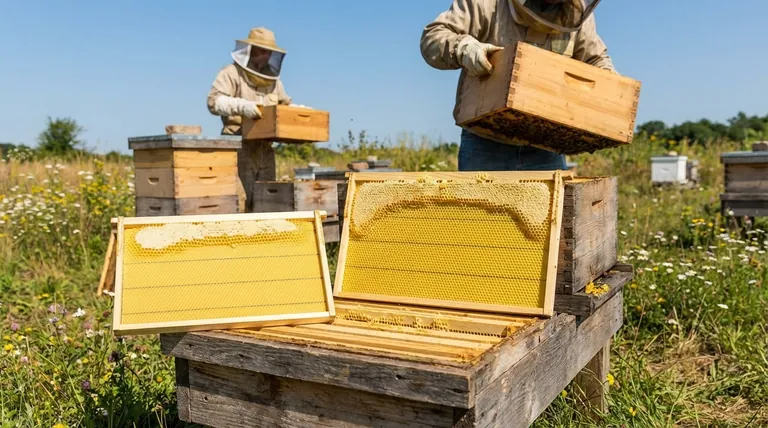The primary difference is height. While shallow and medium bee hive frames share the same length to fit a standard Langstroth hive, a medium frame is taller at 6 1/4 inches, whereas a shallow frame is shorter. This seemingly small difference in height has significant consequences for weight, honey storage, and overall hive management strategy. The frame size you choose must match its corresponding box, known as a "super."
Your choice between shallow and medium frames is not merely about equipment size; it's a strategic decision that balances honey yield against manageable lifting weight. Medium frames offer more honey per box but are significantly heavier, while shallow frames are lighter and easier to handle.

The Core Difference: A Matter of Height and Compatibility
The confusion between shallow and medium frames is understandable. They have identical lengths and widths, designed to fit perfectly within the horizontal dimensions of a standard hive body. The distinction lies entirely in their vertical measurement.
Medium Frame and Super Dimensions
A medium frame is 6 1/4 inches tall.
It is designed to be used exclusively in a medium super, which stands 6 5/8 inches tall. This specific pairing ensures the correct "bee space" is maintained above and below the frames, preventing bees from building unwanted brace comb.
Shallow Frame and Super Dimensions
A shallow frame is shorter, typically measuring 5 3/8 inches tall.
As expected, it belongs in a shallow super, which is approximately 5 3/4 inches tall. Using a shallow frame in a deeper box would create excessive space, which the bees would quickly fill with disruptive comb.
The Unbreakable Rule of Compatibility
The most critical principle is that the frame must match the super. You cannot mix and match sizes. A medium frame will not physically fit inside a shallow super, and placing a shallow frame in a medium super creates operational problems.
Understanding the Trade-offs: Weight vs. Yield
Choosing a frame size goes beyond simple measurements. It directly impacts your physical effort and the efficiency of your honey harvest.
The Advantage of Medium Frames: Higher Yield
Because they are taller, medium frames have a larger comb surface area. This means they can hold more honey than shallow frames.
A full medium super is a dense, efficient package of honey. This translates to fewer frames to uncap and extract for the same amount of honey, streamlining your harvest process.
The Disadvantage of Medium Frames: The Weight Factor
This higher yield comes at a significant cost: weight. A medium super full of honey can weigh 40 to 50 pounds (18-23 kg).
Lifting multiple boxes of this weight can be strenuous and is a serious consideration for any beekeeper, especially those with physical limitations.
The Case for Shallow Frames: Easy Handling
The primary benefit of shallow frames is their manageable weight. A full shallow super typically weighs around 30 to 35 pounds (13-16 kg).
This lighter weight makes hive inspections, manipulations, and harvesting far less physically demanding, reducing the risk of strain or injury.
The Downside of Shallow Frames: More Equipment
The trade-off for lighter boxes is that you need more of them to store the same amount of honey. To achieve the harvest of two medium supers, you may need nearly three shallow supers, meaning more equipment to buy, store, and manage.
Making the Right Choice for Your Goal
Your decision should be based on a clear understanding of your personal goals and physical capacity. There is no single "best" answer, only the best choice for you.
- If your primary focus is maximizing honey yield per box: Choose medium frames and supers, as they provide the most efficient storage-to-equipment ratio, provided you can safely handle the weight.
- If your primary focus is easy lifting and manageable weight: Choose shallow frames and supers to make hive work less physically demanding, even if it means handling more boxes.
- If your primary focus is operational simplicity: Standardize all your honey supers to one size—many beekeepers choose mediums as a popular compromise between yield and effort.
Ultimately, the best frame size is the one that aligns with your beekeeping philosophy and physical capabilities.
Summary Table:
| Feature | Shallow Frame | Medium Frame |
|---|---|---|
| Height | 5 3/8 inches | 6 1/4 inches |
| Full Super Weight | 30-35 lbs (13-16 kg) | 40-50 lbs (18-23 kg) |
| Honey Yield per Box | Lower | Higher |
| Physical Effort | Easier to lift and handle | More strenuous |
| Ideal For | Beekeepers prioritizing easy handling | Beekeepers prioritizing honey yield per box |
Ready to Equip Your Apiary with the Right Frames?
Choosing the correct frame size is a critical decision that impacts your efficiency and physical comfort. HONESTBEE supplies high-quality shallow and medium frames, along with all necessary beekeeping supplies and equipment, to commercial apiaries and distributors through our wholesale-focused operations.
We help you maximize your honey production while ensuring your equipment is manageable and effective. Let us provide the reliable gear you need to succeed.
Contact HONESTBEE today to discuss your wholesale needs and get the right equipment for your operation!
Visual Guide

Related Products
- Assembled Wooden Bee Frames with Beeswax Foundation Ready to Use by HONESTBEE
- Assembled Wooden Bee Frames with Plastic Foundation for Durability and Convenience by HONESTBEE
- HONESTBEE Wired and Assembled Wooden Bee Frames Foundation for a Thriving Hive
- Plastic Bee Frame Beekeeping Hive Frames for Wholesale
- Professional Wooden Requeening Frame for Beekeeping
People Also Ask
- What are the main parts of a hive frame? A Guide to Modern Hive Anatomy
- How many frames fit in a 10 frame hive? A Guide to Maximizing Your Hive's Potential
- Can old bee frames be reused? Weighing the Risks vs. Rewards for Your Hive
- How are Langstroth beehive frames assembled? A Step-by-Step Guide for a Durable Hive
- What are the advantages of using wooden beehive frames? Natural, Sustainable, and Bee-Friendly



















